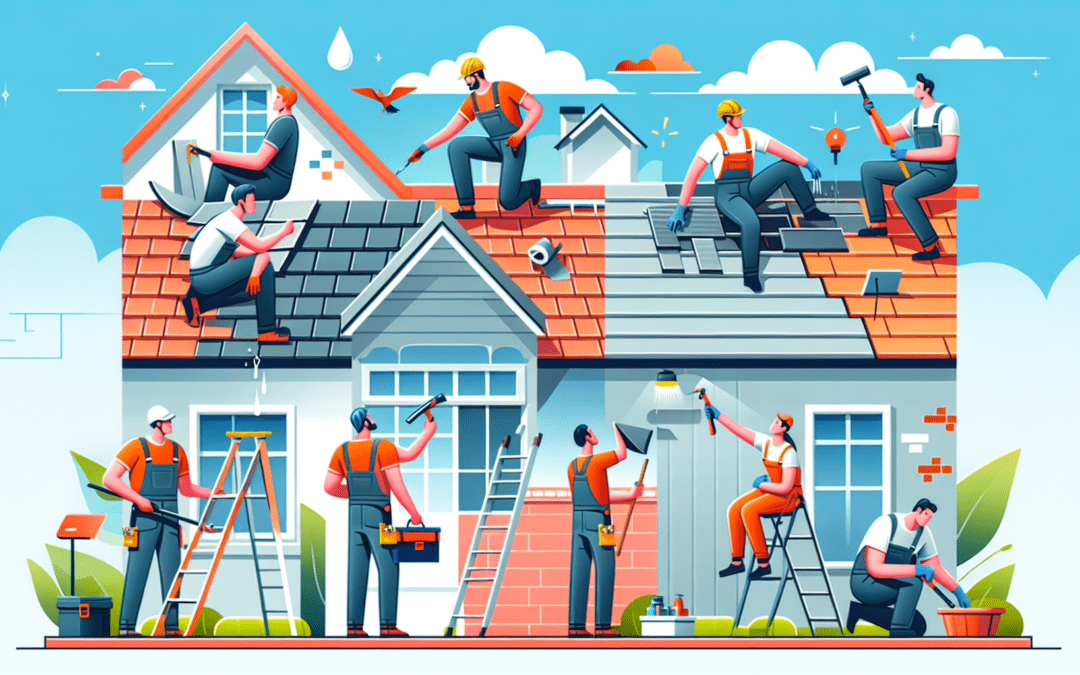
Aug 9, 2023 | Contractors, Roofing
Choosing the Right Roofing Services for Your Home
When it comes to maintaining the structural integrity of your home, few things are as important as your roof. It protects you from the elements, insulates your home, and has a significant impact on your property’s curb appeal. Consequently, whether you’re in need of repairs, a replacement, or routine maintenance, selecting the right roofing service is paramount. Here are some key factors to consider to ensure you make the best decision for your home and budget.
Evaluate Their Reputation and Experience
The roofing industry, like any other, has its share of professionals and, unfortunately, disreputable operations. Start your search by seeking recommendations from friends, family, or neighbors who have recently had roofing work done. Online reviews and ratings on platforms such as Google, Yelp, and the Better Business Bureau (BBB) can also provide insight into a company’s reputation and workmanship. Additionally, inquire about the company’s experience, specifically with your roof type, as this will significantly influence the quality of service you receive.
Check for Licensing and Insurance
Before making any commitments, verify that the roofing service is properly licensed and insured. A legitimate service should hold a valid license for roofing work in your state or locality, which demonstrates that they meet industry standards and regulations. Equally critical is insurance coverage, including liability and workers’ compensation, which protects you from potential liabilities in the event of accidents or damage during the roofing project.
Get Multiple Quotes and Understand the Scope of Work
It’s wise to obtain quotes from several roofing services to compare prices, timelines, and understand the scope of the work each proposes. Ensure that the quotes are detailed, listing the materials to be used, labor costs, timeline for completion, and any other expenses. This not only helps you budget accordingly but also provides a basis for negotiation and helps avoid hidden costs. However, remember that the cheapest option is not always the best. Quality of materials and service should never be compromised for cost.
Look at Past Work and References
A reputable roofing contractor should be able and willing to show you examples of their past work. This may be in the form of a portfolio on their website or before-and-after pictures of recent projects. Requesting references and actually following up with them can also give you a better sense of the company’s reliability, work ethic, and customer service experience.
Ensure They Offer a Warranty
Finally, a critical factor in choosing a roofing service is the warranty. Not only should the materials have a manufacturer’s warranty, but the roofing contractor should also offer a warranty on labor. This provides peace of mind that if anything were to go wrong after the project is completed, you’re covered. Be sure to understand the terms of the warranty, including its duration and what it covers.
Choosing the right roofing service for your home requires due diligence and careful consideration. By focusing on a company’s reputation, credentials, transparency in pricing, past work quality, and the warranties offered, you can ensure your roofing project will be completed to a high standard. Remember, your roof is a critical component of your home, and entrusting its care to the right professionals is paramount to your home’s longevity and safety.

Jul 7, 2023 | Roofing
What Causes Bubbles in Rubber Roofs and How to Fix Them
Have you ever seen rubber roofs with bubble-like bumps on them? It’s a common issue, but it doesn’t mean it can’t be fixed. Rubber roofs, also known as EPDM roofs, are popular because they’re strong and can last a long time. However, sometimes bubbles or blisters form on the surface. Let’s find out why this happens and what you can do about it.
Why Do Bubbles Appear on Rubber Roofs?
Bubbles on rubber roofs can show up for a few reasons. One big reason is when air gets trapped between the roof deck (the base layer of your roof) and the rubber membrane itself. This can happen during installation if the rubber sheet isn’t laid out flat or if moisture gets underneath it. Heat from the sun can make these air pockets expand, forming bubbles.
Another reason for these bubbles could be moisture being trapped. If the rubber roof is installed on a damp day, or if there’s moisture in the roof deck, it can get trapped. Over time, this trapped moisture can turn into vapor, which expands and creates bubbles.
How to Fix Bubbles in Rubber Roofs
Fixing bubbles in rubber roofs is necessary to keep the roof working well and looking good. Here’s what can be done:
1. Let it Be
Small bubbles might not be a big deal. Sometimes, they don’t affect the roof’s performance and might disappear on their own. But, it’s always a good idea to keep an eye on them to make sure they don’t get bigger.
2. Repair Small Bubbles
If a bubble is small, you might be able to fix it yourself. You can cut a slit in the bubble to let out the air or moisture. Then, using a special glue made for rubber roofs, you can glue the cut edges back down. This stops the bubble from coming back and getting bigger.
3. Replace Part of the Roof
For larger bubbles, or if there are a lot of them, you might need to replace part of the roof. This means cutting out the section with bubbles and putting in a new piece of the rubber membrane. It’s usually best to have a professional do this to make sure it’s done right.
Preventing Bubbles on Rubber Roofs
To stop bubbles from forming in the first place, make sure the roof is installed correctly. The roof deck should be clean, dry, and smooth. Also, it’s important to check the roof regularly for any signs of damage or moisture. Quick action can prevent small issues from becoming bigger problems.
Dealing with bubbles in a rubber roof can seem daunting, but it’s usually manageable. Whether you fix them yourself or get help from a professional, taking care of bubbles early on can help keep your roof in good shape for years to come.

May 3, 2023 | Industry News, Marketing, SEO, Web Design
Introduction to Contractor Marketing Services
In today’s competitive business environment, contractors across various industries such as construction, electrical, plumbing, and HVAC, face the challenge of not only delivering high-quality services but also effectively marketing their businesses. The right marketing strategies can dramatically increase visibility, appeal to potential customers, and boost profitability. This article explores top contractor marketing services that can help contractors strengthen their market presence and achieve business growth.
Understanding Digital Marketing for Contractors
Marketing for contractors has evolved significantly over the last decade with digital marketing becoming increasingly significant. Digital marketing for contractors involves various strategies aimed at reaching potential customers through digital platforms such as search engines, social media, email, and websites. A tailored digital marketing approach can help contractors not only survive but thrive in this competitive market.
SEO (Search Engine Optimization)
SEO is a crucial element of digital marketing that involves optimizing a website to rank higher in search engine results, making it easier for potential customers to find a contractor’s business online. For contractors, local SEO is particularly important as it optimizes visibility for local searches, which can directly lead to job opportunities and increased revenue. Effective SEO strategies include using relevant keywords, optimizing website content and structure, building backlinks, and ensuring the website is mobile-friendly.
PPC (Pay-Per-Click) Advertising
PPC is an internet advertising model used to drive traffic to websites, where an advertiser pays a publisher (typically a search engine, website owner, or a network of websites) when the ad is clicked. PPC campaigns can be highly targeted, offering immediate results that are easy to measure and track. They are particularly useful for contractors as they can target potential customers who are actively searching for specific services in real-time.
Social Media Marketing
Social media platforms like Facebook, Instagram, and LinkedIn offer powerful tools for building brand awareness and engagement. Contractors can use these platforms to showcase their work, share customer testimonials, provide helpful DIY tips, and communicate with potential and existing customers. Social media ads can also be highly targeted based on geographic location, demographics, interests, and behaviors, making them a cost-effective way to increase visibility and generate leads.
Email Marketing
Email marketing remains one of the most efficient ways to maintain relationships with existing customers and reach new ones. Contractors can use email newsletters to share important updates, promotions, new services, or tips that homeowners and businesses might find useful. Segmenting email lists based on customer interests or past projects can lead to higher engagement rates and conversion.
Website Design and Optimization
A professional, user-friendly website serves as the base of a contractor’s online presence. An optimized website must be visually appealing, mobile-responsive, and easy to navigate. It should clearly communicate what services are offered, where they are offered, and how potential customers can request these services. Additionally, integrating strong calls-to-action (CTAs) can guide visitors towards engaging with the contractor’s business, whether through filling out a contact form, signing up for a newsletter, or making a phone call.
Reputation Management and Online Reviews
For contractors, reputation can be everything. Many potential customers will research online reviews and testimonials before deciding to hire a contractor. Actively managing these reviews by responding to feedback, addressing concerns in a professional manner, and encouraging satisfied customers to leave positive reviews can significantly influence public perception and lead conversion rates.
Case Studies and Content Marketing
Showing off past projects through detailed case studies or portfolio galleries can significantly enhance a contractor’s credibility and attract higher-quality leads. Content marketing can also play a role here by demonstrating expertise through in-depth blog posts, videos, and infographics that help potential customers solve problems or learn more about common industry issues.
Summary
Contractor marketing services are essential tools in a contractor’s arsenal for attracting and retaining customers. By leveraging SEO, PPC, social media marketing, email marketing, and effective website design, contractors can enhance their online presence, build trust with their audience, and ultimately, grow their business more effectively. Finally, maintaining a strong reputation online and showcasing skills through content marketing are invaluable tactics for long-term success.





